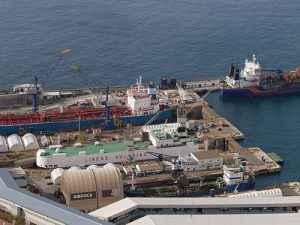
Surge of bookings at ship repair specialist Gibdock
DECEMBER 23, 2015—Gibraltar-based ship repairer Gibdock reports that a surge in bookings by new and repeat customers into the first two quarters of 2016 will propel it in the first half of

DECEMBER 23, 2015—Gibraltar-based ship repairer Gibdock reports that a surge in bookings by new and repeat customers into the first two quarters of 2016 will propel it in the first half of
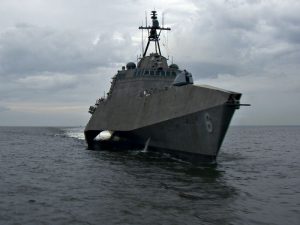
DECEMBER 22, 2015 — Austal USA has been awarded a contract modification that adds$51,684,797 to its 10-ship $3.5 billion Littoral Combat Ship (LCS) contract for the U.S. Navy. The shipbuilder says the
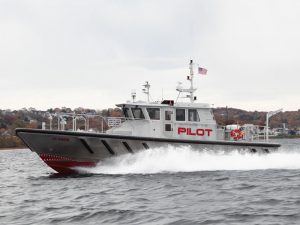
Designed by C. Raymond Hunt & Associates, the all-aluminum pilot boat is 52.6 ft long overall and has a 17-ft beam and 4.8-ft draft.
With a top speed of 25 knots, it is powered by twin Volvo Penta D16 diesel engines, each delivering 651 bhp at 1,800 rpm, turning five-bladed NiBrAl propellers via ZF 500-1-A gearboxes.
Each engine has a two-circuit Fernstrum keel-cooling system recessed into extra heavy bottom plating for operation in ice.Volvo Penta’s EVC system is mounted at the control stations in the wheelhouse and at the transom.The vessel is fitted with a Humphree Interceptor automatic trim optimization system.
The wheelhouse is outfitted with five Stidd seats and a three-zone, diesel-fired Espar Hydronic 35 heater for the cabin, main deck, and handrails. The forward wheelhouse windows feature ¾-inch electrically-heated laminated glass for de-icing. Interior sound levels are approximately 78 dba.
At the transom is a winch-operated rotating davit over a recessed platform for pilot rescue operation.
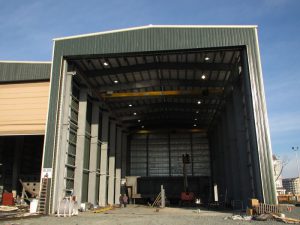
The new building is 160 feet long by 70 feet wide and 70 feet high and will allow larger hull sections to be construction in an indoor environment at the shipyard.
The building provides advanced climate control and has been fitted with two overhead cranes and state-of-the-art equipment.
It is large enough to accommodate the construction of complete tugboats or large hull sections in a controlled indoor environment.
Currently under construction in the building is an aft module of Hull 119, a 275 ft. coastal cruise ship.
The building demonstrates Chesapeake’s continuing commitment to quality and continuous improvement. The yard has upgraded its production capacity significantly in recent years, by acquiring additional land, building two new hull fabrication buildings and investing in additional automated equipment.
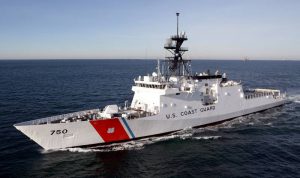
No mystery why the ninth NSC is in the legislation. It was put into 2016 Homeland Security appropriations bill (which was wrapped into the omnibus bill) by Senator Thad Cochran (R-MS), who is chairman of the Senate Appropriations Committee, even though it was widely criticized as “an unnecessary acquisition.”
“The demands on the Coast Guard to protect our coasts and waterways from terrorism, human trafficking, drug smuggling and other maritime threats are not diminishing. They’re increasing and will continue to do so as its jurisdiction in the Arctic region expands. The National Security Cutter is the best weapon we have to meet that demand,” said Senator Cochran, back in June. “The current Coast Guard production goal for only eight National Security Cutters is based on dated assessments and is insufficient to meet current or future requirements,”
“I am pleased that the Senate bill would maintain the national security cutter production line in order to give the Coast Guard more certainty and capabilities to meet its operational requirements,” he added.
The NSC production line is, of course, in Senator Cochran’s home state at the Pasagoula, MS, shipyard of Huntington Ingalls Industries’ Ingalls Shipbuilding Division.

CSL received the license after successfully completing the GTT qualification process including membrane tank mock-up installation. It is the first Indian shipyard to be licensed by GTT.
“Obtaining this technology has made a significant positive change to the technical competence and stature of this yard,” said Commodore K Subramaniam, Chairman and Managing Director of CSL. “Going forward, we feel that this technology would help the yard to tap the huge shipbuilding prospects in the LNG vessel segment. Our partnership with Samsung Heavy Industries (SHI) has been a critical factor in CSL completing GTT’s stringent qualification requirements.”
Philippe Berterottière, Chairman and CEO of GTT said that the agreement “marks the beginning of a promising cooperation with CSL. He added thta “building LNG ships in India, with the assistance of Samsung Heavy Industries, will not only enhance the initiative of the ‘Make in India’ objective of the Government of India, but will also provide excellent opportunity to an Indian shipyard in the growing LNG market”.
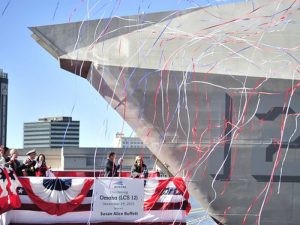
The GAO report, an unclassified version of a report published in July, was released as news surfaced that Secretary of Defense Ash Carter, in a Dec. 14 memo to Navy Secretary Ray Mabus, had told the Navy to reduce the planned LCS/FF shipyard procurement from 52 to 40 and to downselect to one variant by FY 2019 (see earlier story).
The GAO reiterates a number of arguments made by critics of the program. It says that the lethality and survivability of the Littoral Combat Ship (LCS) remain l largely unproven, six years after delivery of the lead ships.
According to GAO, LCS was designed with reduced requirements as compared to other surface combatants, and the Navy has since lowered several survivability and lethality requirements and removed several design features—making the ship both less survivable in its expected threat environments and less lethal than initially planned. The Navy is compensating for this by redefining how it plans to operate the ships.
In 2014, the Navy conducted its first operational test of an early increment of the surface warfare mission package on a Freedom variant LCS, demonstrating that LCS could meet an interim lethality requirement. The Navy declared LCS operationally effective. However, says the GAO, the Navy’s test report stated that the ship did not meet some key requirements.
Further, the Department of Defense’s Director of Operational Test and Evaluation has stated that there is insufficient data to provide statistical confidence that LCS can meet its lethality requirements in future testing or operations, and further testing is needed to demonstrate both variants can meet requirements in varied threat environments.
The Navy also has not yet demonstrated that LCS will achieve its survivability requirements, and does not plan to complete survivability assessments until 2018—after more than 24 ships are either in the fleet or under construction, says GAO.
The Navy has identified unknowns related to the use of aluminum and the hull of the Independence variant, and plans to conduct testing in these areas in 2015 and 2016. However, the Navy does not plan to fully determine how the Independence variant will react to an underwater explosion.This variant also sustained some damage in a trial in rough sea conditions, but the Navy is still assessing the cause and severity of the damage and GAO has not been provided with a copy of the test results.Results from air defense and cyber security testing also indicate concerns, but specific details are classified.
Read the GAO report HERE

DECEMBER 19, 2015 — The U.S. Equal Employment Opportunity Commission (EEOC) reports that bankrupt Mobile, AL, headquartered shipbuilding and repair company Signal International, LLC will pay an estimated $5 million to 476
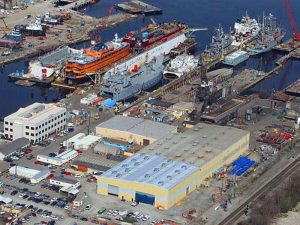
DECEMBER 18, 2015 — Virginia Governor Terry McAuliffe announced today that Colonna’s Shipyard, Inc. will invest over $30 million to expand its operation in the City of Norfolk, VA, creating 51 new
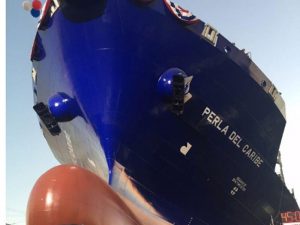
DECEMBER 18, 2015 — General Dynamics NASSCO reports that on December 11 itsuccessfully completed bunkering of liquefied natural gas (LNG) for TOTE Maritime’s Perla Del Caribe, the world’s second containership to be